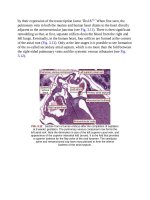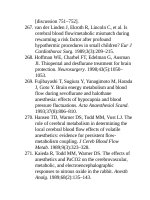Andersons pediatric cardiology 165
Bạn đang xem bản rút gọn của tài liệu. Xem và tải ngay bản đầy đủ của tài liệu tại đây (128.69 KB, 3 trang )
sideoftheheart,estimatedathalfofthereturningflow.Thedegreeofshunting
inthehumanfetusisless,beingestimatedatbetweenone-quarterandtwofifths.49Thedeterminantsofshuntingincludethedifferingresistancesofthe
portalvasculatureandvenousduct,alongwithotherinfluencessuchasblood
viscosity,umbilicalvenouspressure,andmechanismsofneuralandendocrine
control.Thewaveformsmeasuredwithinthevenousducthavebeenfoundto
remainnormalforlongperiodsduringplacentalcompromise,reflectingits
essentialroleinthefetalcirculation.65Patternsintheumbilicalveinalsoactasa
barometeroffetalwell-being.Thesearecausedbythedilationofthevenous
ductinresponsetofetalhypoxemiathatreducesimpedanceandallowspressure
wavestotravelinaretrogradefashionfromtherightatriumtotheumbilicalvein
resultinginvenouspulsations.Absentorreversalofflowinthevenousductis
usuallyanominoussign(Fig.6.10).Itreflectsfetalhypoxemiaandhasbeen
showntopredictfetaldeathoradverseperinataloutcome.61–63andusually
promptsemergencydeliverybycesareansection.Analternativeetiologyfor
absentorreversedend-diastolicflowinthevenousductisincreasedcentral
venouspressure,seenparticularlywherethereisobstructionwithintheright
heart,suchaspulmonaryatresiawithseveretricuspidregurgitation(Video6.9).
Thismayalsoresultinfetalhydropsandintrauterinedeath.66–68
FIG.6.10 SeriesofDopplerrecordingsinthevenousductillustrating
worseningcardiacfunction.(A)Thenormalpatternshowsforwardflow
towardtherightatriumthroughoutthecardiaccycle.(B)Impaired
ventricularfillingisassociatedwithabsentend-diastolicflowinthe
waveform.(C)Worseningfunctionischaracterizedbyareversalofflow
coincidentwiththe“a”waveofatrialcontraction.
FlowtotheBrain
Dopplerwaveformssignifyingnormalbrainflowinthemiddlecerebralartery
arecharacterizedbyanexpectedpeaksystolicvelocity(incentimetersper
second)ofapproximatelytwicethefetalgestationalageandapositivediastolic
tail(seeFig.6.8A).AbnormalityoftheDopplerwaveformssignifiedfetal
hypoxemia,69butinitialreportsthatflowwaveformsintheanteriorcerebral
arterywerebetterabletopredictadverseneurodevelopmentaloutcomehavenot
beensubstantiated.70,71Insheepstudiesthepulsatilityinthemiddlecerebral
arterywasfoundtocorrelatepoorlywithperipheralvascularresistance,72butthe
clinicalapplicationofthecerebraltoplacentalresistancesinthehumanfetus
remainsasubjectofdebate.64,73
Oneofthemostpracticalapplicationsofthemiddlecerebralartery
measurementisinthenoninvasivedetectionoffetuseswithanemia,wherean
increaseinthepeaksystolicvelocitywithnormaldiastolicvelocityhasbeen
described.74Thevelocityisproportionaltothereductioninhematocritand
directsmanagementdecisionstoprovidelife-savingfetaltherapyintrauterine
transfusion.75
Infetuseswithintrauterinegrowthrestriction,a“brain-sparing”phenomenon
comprisingincreaseddiastolicvelocitiesinthemiddlecerebralartery,producing
alowpulsatilityindex,hasbeendescribed(seeFig.6.8B).Atdelivery,brain
sparingwasassociatedwithhypoxemiaandabnormalsystemicvenousflows
withacidemiaandadverseperinataloutcome.61–63Growth-restrictedfetuses
withabnormalvenousflowhaveworseperinataloutcomecomparedwiththose
wheretheabnormalityinflowisconfinedtotheumbilicalormiddlecerebral
arteries.Infetuseswithlowmiddlecerebralarterialpulsatility,anabnormal
systemicvenousDopplersignalindicatesfurtherdeterioration.76Acombination
ofDopplerindexes,showntobepredictiveoftheoptimaltimefordeliveryof
thesickfetus,hasbeenstudiedtoidentifywhethertheyarepredictiveofearly
cerebralinjury,whencombinedwithimagingtechniques.77Evidenceofcerebral
redistribution,asmeasuredbytheratioofthepulsatilityindexesoftheumbilical
arterytothemiddlecerebralartery,wasassociatedwithreducedtotalvolumeof
thebrain.
Autoregulatoryarteriolesaresensitivetothelocalconcentrationofmetabolic
productsbutwillnotfunctionifthesurroundingtissueismetabolicallyinactive.
Thismaymisleadinglymanifestasa“normalization”ofcerebralDopplerflow
waveformsinterminallysickfetusesjustpriortotheirintrauterinedeath.78
However,newertechniquesusingMRImaybeabletoprovidenoninvasivein
vivoassessmentoffetalcerebralmetabolismanditsresponsetoadverse
intrauterineconditionsandcongenitalmalformations.Bloodoxygen–dependent
MRImeasurestherelativestateofoxygenationinthefetusbycomparingthe
differencingmagneticpropertiesoftheoxygenatedanddeoxygenated
hemoglobin.ThiscanbedetectedusingT2-weightedimagingandhasbeen
evaluatedinbothsheepandhumanstudies.79–83









